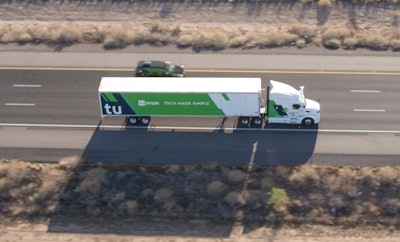As we’ve reported, last month the U.S. Department of Transportation released its updated guidance on automated vehicles, AV 3.0. It’s intended to clean up outdated or muddy policies and steer the private sector in developing new technologies while working closely with regulators.
One highlight: “Driver” and “operator,” DOT says, “do not refer exclusively to a human, but may in fact include an automated system.”
 TuSimple is using Peterbilts at Level 4 autonomy to haul commercial cargo daily along I-10 in Arizona.
TuSimple is using Peterbilts at Level 4 autonomy to haul commercial cargo daily along I-10 in Arizona.This simple recognition also hints at complexities ahead. While autonomous trucking entrepreneurs are making rapid inroads, the holy grail of Level 5 autonomy – true driverless operation – seems to drift further away with every report of an autonomous car accident. I spoke about this with Kelly Regal, associate administrator of research and information technology for the Federal Motor Carrier Safety Administration.
“What we’re hearing from developers is they’re not really even close to a Level 5 commercial motor vehicle,” she said. “The focus is on Level 4 at the moment. Level 5 is really difficult.”
A Level 4 vehicle has the technology for fairly advanced driving, even doing something as subjective as judging when it’s safe to change lanes. Additional requirements at Level 5, less focused on navigation and more on critical interaction and analysis, will require more work. A lot more work.
Imagine a vehicle trying to interact with an officer directing traffic at an intersection where the light is out, or how a truck would respond to a trooper trying to pull it over. And considering that self-driving does not mean self-maintaining, driverless trucks will get cited for equipment violations. How will that process work?
As for such points, FMCSA expects to initiate by yearend an advance notice of proposed rulemaking to address autonomy. It would identify regulatory gaps, including inspection, repair and maintenance, said Larry Minor, an associate administrator at FMCSA.
Meanwhile, autonomous truck research and development is moving along. To cite but one example, an autonomous tech leader, TuSimple, plans to have 200 Level 4 trucks on the road next year, writes Aaron Huff of sister publication Commercial Carrier Journal, reporting from a McLeod Software user conference.
Chief Executive Tom McLeod believes the transportation management software used by shippers, brokers and fleets can evolve “to power an autonomous freight environment” in a highly sophisticated way, Huff reported. “Loads will be dispatched to driverless trucks and exceptions managed from pickup through delivery,” McLeod said.
As such expectations spread, the public-private coordination encouraged by AV 3.0 should help clarify how to get there. With a sobering awareness of driverless truck challenges, the road to Level 5 trucking should be a very long one. That would be good for safety, not to mention preservation of driver jobs.
Comment on the guidance through Nov. 7 by searching for DOT-OST-2018-0149.







